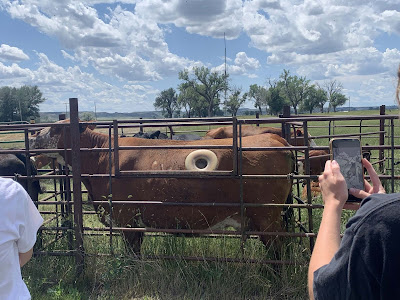Science can’t just be science
Guest post by student Camryn Brown -
This section of our trip has been all about soil, Montana history, and wrapping up any loose ends. We started it off by visiting Little Bighorn Battlefield National Monument. I love visiting national park sites, so I was very excited to visit here! Little Bighorn Battlefield was surprisingly very crowded. People were everywhere. I realized only after walking through the battlefield that it was because it was the day before the anniversary of the battle. At the Battle of Little Bighorn, the Americans, led by General Custer, were defeated by the Lakota Sioux. The museum taught us about how Custer and his men didn’t stand a chance against the Sioux. After the battle was over, the Sioux and Custer agreed to never let anything like that battle happen again. Sustainability doesn’t have one definition. It means to remember and learn from the past.
Our research goal of this section was to collect soil samples from every plot so we could identify the amounts of key nutrients available to the plants. The plan was to use a special drill to remove the first six inches of soil, collect them in bags, and take them back to Clemson for analysis. However, this season has been extremely wet. We had to stop working some of the days because the weather was so bad, which means that the soil was soaked. Because of this, we were unable to collect any soil samples. Our TA, Ethan, plans to collect them once everyone has left and the soil has dried up, so that we still get to analyze the nutrient contents. This course has taught me to swing with the punches, because research is never perfect and you will have to adapt and change your plans when Mother Earth has different plans. This will definitely be useful in the future! Instead of collecting soil samples, we had the time to add additional plots. We added one plot in each treatment, meaning thinned and burned, thinned and unburned, unthinned and burned, and unthinned and unburned. This means we have more data, which will decrease the bias and give us a truer and more accurate analysis.
We met two extension agents from Montana State University and learned about what they do for work. This was the first time I have heard of extension agents so I was curious to hear what they had to say. Their job is essentially to help anyone that has a question about plants, cattle, or anything concerning farming so that everyone can be successful in completing their goals. Because of their position, they work equally with cattle ranchers and the general public. They said that there has to be a common ground between the two groups, or else the environment in Montana will only get worse, causing more havoc in everyone's lives. They focused particularly on wildfires. They hold classes to help everyone learn how to protect not only their land, but their homes as well. They said that there should be a balance between cutting down trees and leaving them be. They’re important because wildlife need trees to ensure their survival but too many trees will cause a wildfire to burn harder and hotter. The general public fights this because they want as many trees on their land as possible and ranchers don’t want any trees so there is more land to graze. They are trying to change both groups' perspectives. Their work shows that science can’t just be science. It needs to be broadcasted and taught repeatedly so that it is common knowledge for everyone. Communication with the public is one of the most important parts of science and research.
On our last day, we visited Fort Keogh, the Livestock and Ranch Research Laboratory here in Montana. I have been to research labs in the past, but nothing like this. It is the second largest ranch research lab in the United States. We learned about how they raise their cattle, their experiments concerning soil nutrients, and their cannulated cows. I have never heard of cannulated cows, and although I am squeamish, it was cool to learn about it. We even had a chance to feel inside the cannulated cow, but I opted out.
As I finish my time here in Montana, I am tired but looking forward to the road ahead. I can’t wait to get into the lab and finish the work that we started here.



